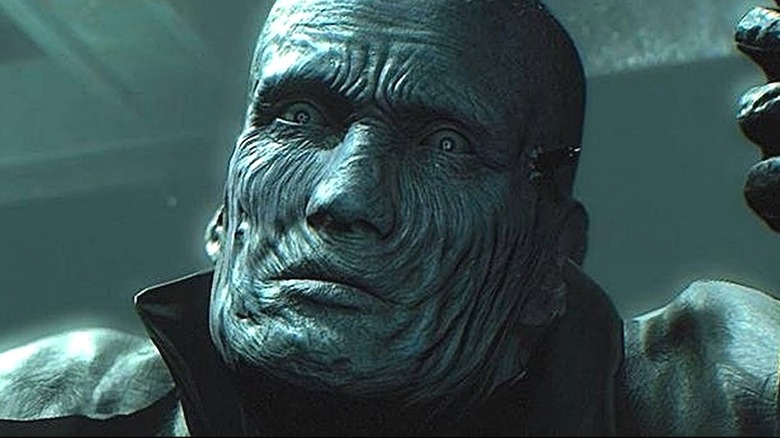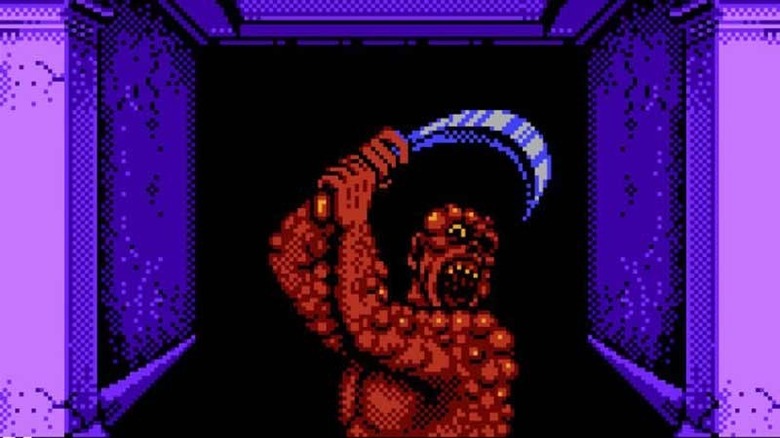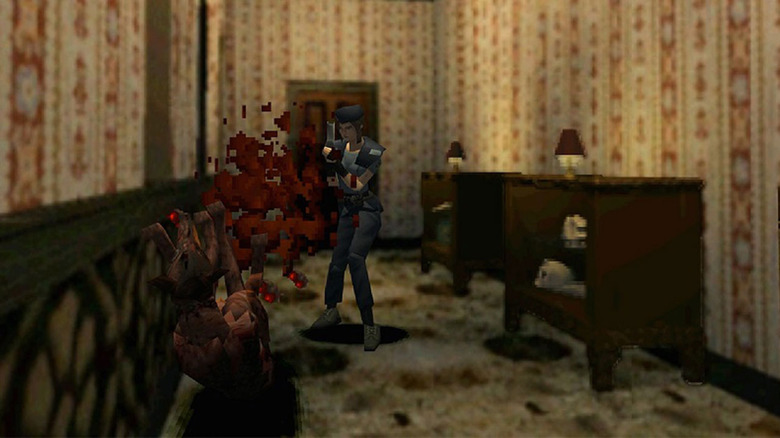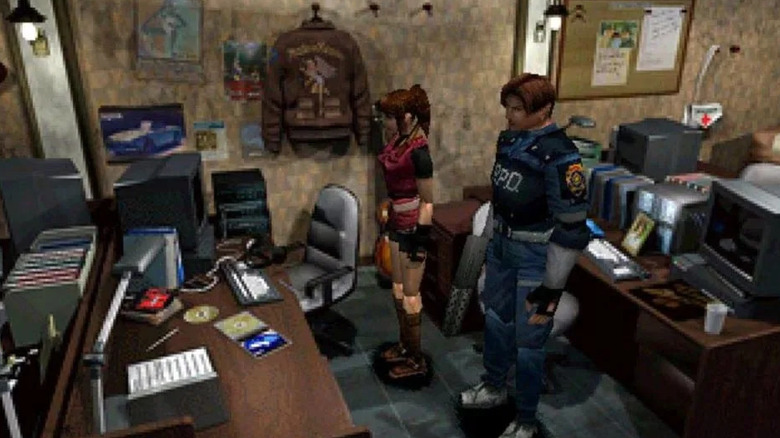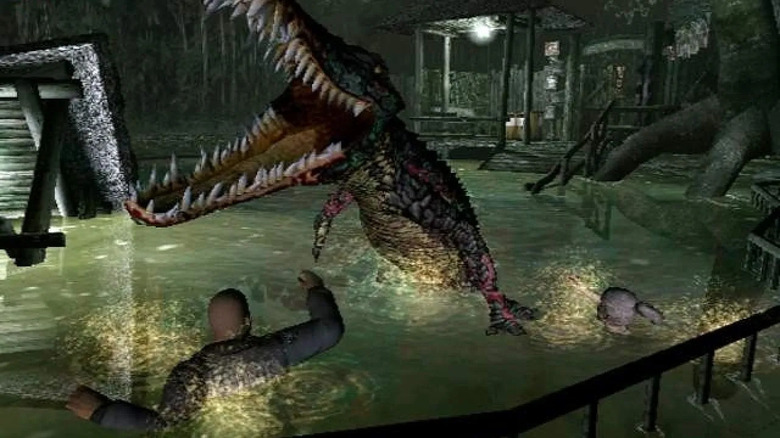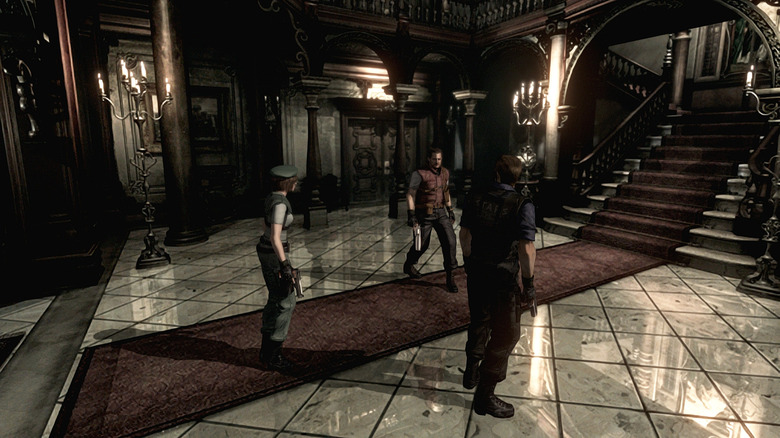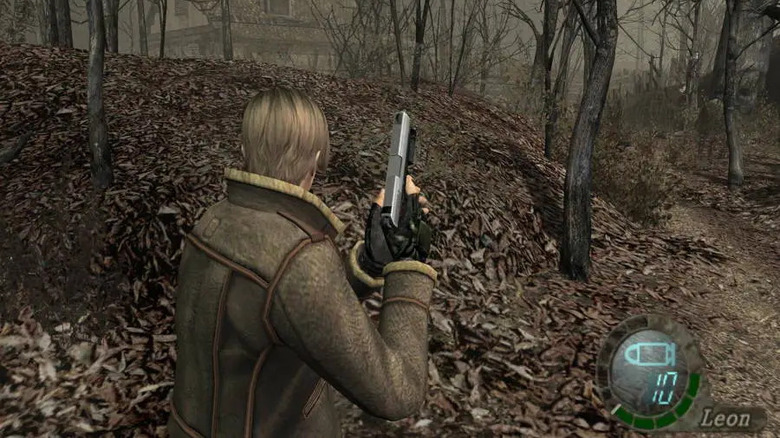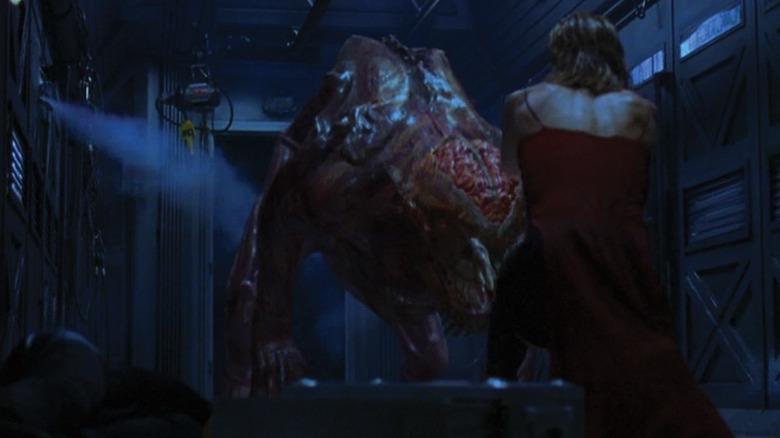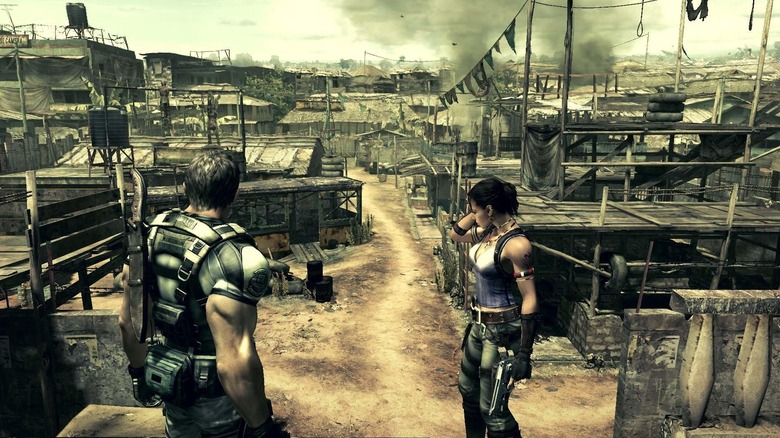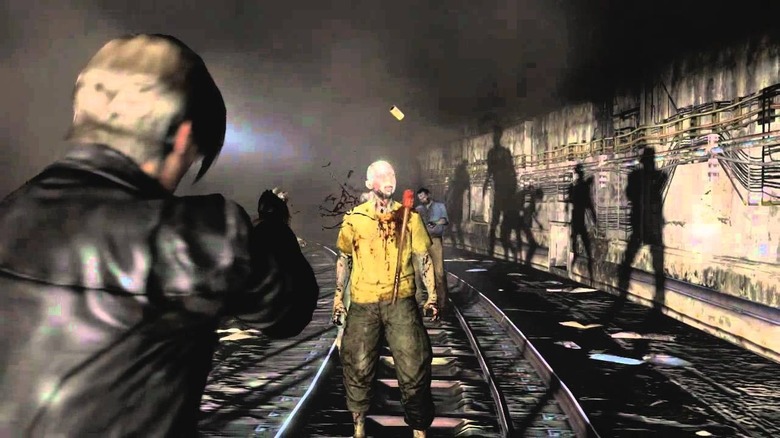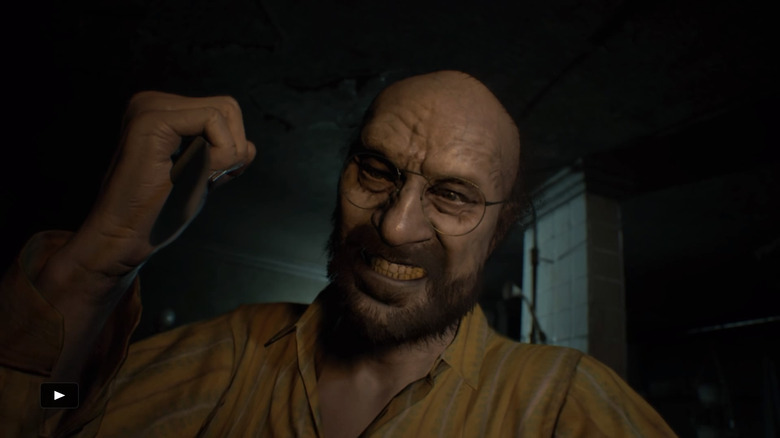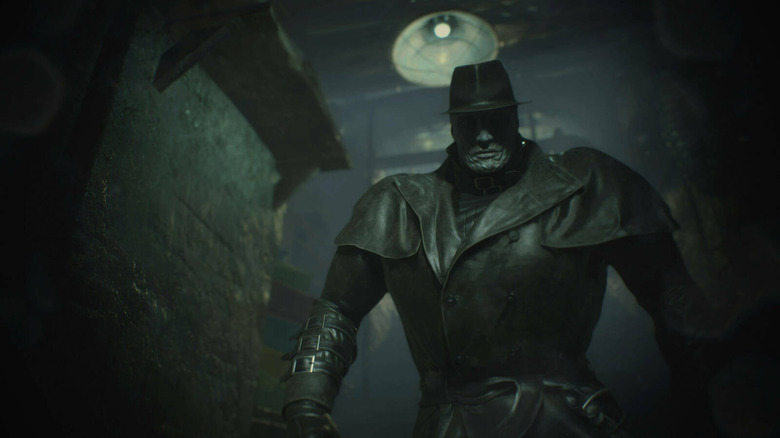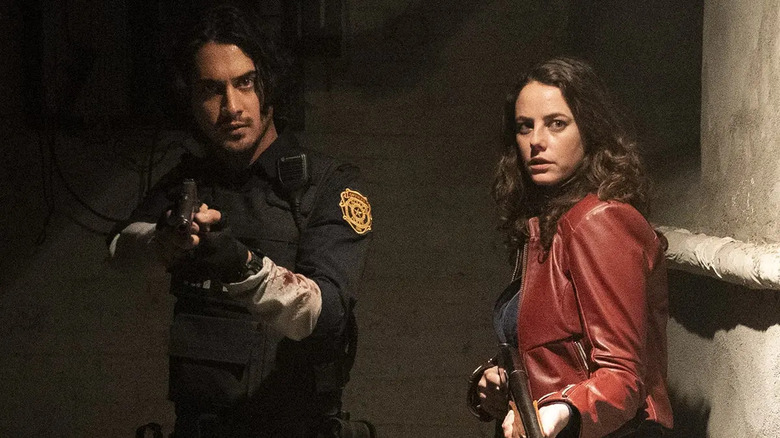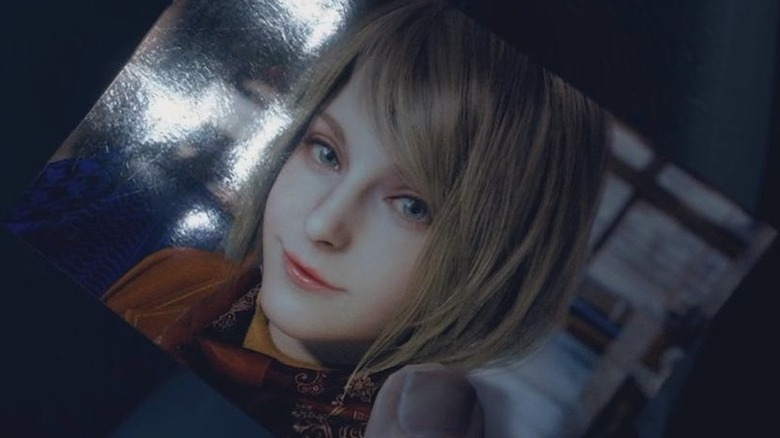The Stunning Transformation Of Resident Evil
"Resident Evil" is a horror behemoth. The name recognition for the franchise has extended well beyond gaming for some time now, as the series has spawned numerous movies and TV adaptations of the characters and settings. But it all began at Japanese video game studio Capcom in 1995 as a horror project under the leadership of now-legendary developers Shinji Mikami and Tokuro Fujiwara. In 1996, the game known as "Biohazard" in Japan would be released as "Resident Evil" in the West, cementing it as a fixture in horror gaming.
Along with "Silent Hill," the fixed camera and tank controls of "Resident Evil" defined a new genre. During the late '90s and early 2000s, "Resident Evil" blazed the path forward for survival horror. But over time, and after years of games and other media adaptations, "Resident Evil" changed. Iconic locations and characters have persisted over the years, but the series has seen some overhauls.
Through the good and the bad, the "Resident Evil" series has evolved, stumbled, and returned to form multiple times. From campy PlayStation horror game to worldwide phenomenon, here's a history of "Resident Evil" through the years.
Before Resident Evil, there was Sweet Home
Before 1996, the term "survival horror" wasn't used much at all. As noted by PC Gamer, though it's easy to trace its legacy back further than "Resident Evil," the influential game is often considered the true beginning of the genre. But when designer Shinji Mikami was first handed the project, it wasn't called "Biohazard," and the name "Resident Evil" was even further off.
The project initially started as a new iteration of the systems seen in the 1989 Famicom game "Sweet Home" (via GameSpot). Never released outside of Japan, this game — along with "Alone in the Dark" — was one of the progenitors of survival horror. According to Den of Geek, Mikami's game would translate the item management and puzzle solving mechanics of the original "Sweet Home" from 2D to 3D.
The title was also originally meant to be played from a first-person perspective, but the switch to a fixed camera was one of many changes that would occur early on in development. The other major change was turning the horror from a supernatural threat to the one we all know now: viral zombies.
In 1996, Resident Evil changed horror gaming forever
One of the most influential horror games of all time, the original "Resident Evil" was released in 1996 to critical acclaim. Originally just on PlayStation, the game was ported to PC and Sega Saturn by 1997. Even before the official 2002 remake, "Resident Evil" got two more release on PS1, bringing the story of the Umbrella Corporation's horrible experiments to new players. Since the game was a big hit and "Resident Evil 2" was taking longer than expected, both a Director's Cut and DualShock version were released in the intervening years (per GamesRadar).
This first game's influence is still felt not just in every game in the "Resident Evil" series, but in most horror releases in the entire horror gaming landscape. The original "Resident Evil" brought concepts like fixed camera angles and tank controls to a console audience. It wasn't the most immediately approachable game, but that hostile element is what gave the campy masterpiece an edge. Iconic (and silly lines) quotes about "the master of unlocking" and a "Jill sandwich" are still referenced all these years later. Even today, games are still looking to "Resident Evil" to figure out how to make a tense and thrilling horror experience.
Resident Evil spawned many direct sequels
After "Resident Evil" set the world ablaze, it was only natural that Capcom would want to make a sequel. "Resident Evil" was turned into a franchise with tenacity, and three main sequels would be released by the year 2000. The first sequel, "Resident Evil 2," remains one of the best games in the series, eclipsed only by a handful of games that include its stellar remake from 2019.
When it was released for PlayStation in 1998, "Resident Evil 2" was met with as much acclaim as its predecessor. Taking things in a slightly less campy direction, "RE2" introduced the world to Claire Redfield and Leon Kennedy, two of the franchise's core characters to this day. It also introduced Raccoon City, the small American city that served as ground zero for the zombie outbreak. While it was a success for Capcom, the troubled development of "Resident Evil 2" nearly cost the company the franchise. After one version of the game was thrown out halfway through — now dubbed "Resident Evil 1.5" — development was restarted.
"Resident Evil 3" came out in 1999 and introduced the terrifying villain Nemesis. "Resident Evil: Code Veronica," released on Dreamcast in 2000, was originally envisioned to be the third mainline "Resident Evi,l" but wound up being marketed as a spinoff (via Den of Geek). Both of these games were more action-heavy than "Reisdent Evil 2," but they stuck to the fixed camera that would define the series — for a while, at least.
Spinoffs took the series in strange directions
There were many attempts at spinoffs that branched off into different game genres entirely. The first notable release of these was "Resident Evil Survivor" for the PlayStation. This began the arcade "Gun Survivor" series in Japan, but the only other one of these games to see a release in the US was "Resident Evil: Dead Aim" (via Giant Bomb). This light gun shooter would be the franchise's first real foray into pure action. Capcom would return to the idea years later with "Umbrella Chronicles" and "Darkside Chronicles" for the Nintendo Wii, to varying degrees of success.
"Resident Evil" also attempted to go handheld with "Resident Evil Gaiden" for the Game Boy Color, but the game's odd approach to combat and cliffhanger ending left critics scratching their heads. Other major spin-offs of the era included the two "Resident Evil: Outbreak" games. These are by far the most experimental in the franchise's long history. Released in 2003 and 2004 respectively, the "Outbreak" games were multiplayer survival horror games set in Raccoon City. "Outbreak" translated mechanics from the mainline games to a genre that was maybe just a little bit too ahead of its time. This ambition and lack of polish translated to middling to poor reviews for both "Outbreak" titles, ensuring Capcom never revisited the idea again.
Shinji Mikami returned to remake his original game in 2002
While six years may not feel like a long enough time to justify a remake, the advancements in video game tech between 1996 and 2002. Things were moving fast when game designer Shinji Mikami revisited his horror masterpiece by remaking it for the GameCube. It's a good thing, then, that this wasn't just any old facelift. The gameplay was kept relatively faithful to the original, but there were some quality of life improvements and big content additions, like the haunting story of Lisa Trevor, one of the scariest "Resident Evil" villains. This definitive version of "Resident Evil" feels timeless when compared to the PS1-era titles, as noted by GAMINGbible, setting the bar high for future "Resident Evil" remakes.
Even though it didn't sell that well when it was released (via Destructoid), 2002's "Resident Evil" has gone on to become a fan-favorite entry in the series. The overhauled graphics and design elements give the "Resident Evil" remake a gritty art style that still looks stunning today. An original game was made on this engine later that same year, a prequel entitled "Resident Evil 0." This spin-off is as gorgeous as 2002's remake, but it remains one of the more divisive games in the series for its bizarre plot and occasionally frustrating item management system.
Resident Evil 4 broke new ground and reinvented the franchise
Shinji Mikami also returned for "Resident Evil 4," which is arguably a more important relaunching point than the "Resident Evil" remake. The first main game in the series not to feature tank controls, "Resident Evil 4" took an over-the-shoulder approach that wound up revolutionizing shooters forever. And although some people were put off by the shift to a more action-oriented experience, "RE4" excelled at being a tense, gross-out horror adventure that saved its scariest creatures for the end. As Leon Kennedy from "Resident Evil 2," players are sent to rescue the President's daughter in a remote Spanish village. Instead of zombies, Leon must fend off infected villagers and cultists as he unravels a campy conspiracy.
Compared to the other entries in the series, "Resident Evil 4" took quite a bit of time to make and multiple prototypes have made their way to the public. The earliest version of "RE4" wound up being the start of one of Capcom's other most important franchises: "Devil May Cry." The 2001 hack-and-slash classic began its life as "Resident Evil 4" (per Den of Geek). Footage of an in-development build that fans have dubbed "Biohazard 3.5" has also circulated online, proving the game had fixed camera angles for much of its development (per YouTube). Later demo footage shows the now infamous "hook man," a Mr. X-type stalker enemy that pursued Leon with his giant hook hand.
The difficulty in "Resident Evil 4" is dynamic, giving players a new experience each time while still reliably delivering the same excellent bosses and unforgettable one-liners each time. It even received a great VR port (a truly rare phrase) that captured the magic of the original's combat in a totally new dimension.
The original movies were radically different
The same year that the "Resident Evil" remake came out, a movie also simply called "Resident Evil" showed up in theaters. Paul W.S. Anderson's first stab at the franchise could not be more different from Mikami's remake of the original. The "Mortal Kombat" director took everything he knew about making '90s video game adaptations and gave the world an outlandish, action-forward take on "Resident Evil" starring Milla Jovovich as original character, Alice.
With no real characters in common with the video games aside from a few creature designs, Umbrella's creation of biochemical zombies is about the only connective tissue between the two. Despite poor critical reception, "Resident Evil" used brand recognition and choreographed slow-mo to dominate the box office and launch "Resident Evil" as a full-fledged film franchise. Anderson would go on to be involved with five sequels to "Resident Evil" to various extents — always as a screenwriter — and even returned to the director's chair from "Resident Evil: Afterlife" until the end of series. Over the years, these silly movies went on to develop a dedicated cult following that loves them immensely (via The New Yorker), even though they get a lot wrong about the games.
Animated movies such as "Resident Evil Damnation" would hew closer to the source material, but they weren't the mammoth hits that some of these live-action flicks became.
Resident Evil 5 introduced co-op to the series
There is a sense of dread and isolation that occupies the experience of playing the classic "Resident Evil" games. By the time "Resident Evil 5" was released in 2009, the series had strayed far enough from its roots to add a feature antithetical to the principles the series was founded on. That addition was campaign co-op, and it marked Capcom's full commitment to making "Resident Evil" a premiere action series after the success of "Resident Evil 4."
The focus on co-op action made "Resident Evil 5" yet another turning point in the series. It was the highest-selling game in the series at the time it was released and remains one of Capcom's biggest hits of all time (via Game Informer), selling over 8 million copies to date.
Despite not being true to the horror roots of "Resident Evil," "RE5" was a well-received co-op game. It included a lot of mechanics — like ammo trading — that encouraged players working together outside of the action set pieces. But "Resident Evil" would soon crash and burn.
Resident Evil 6 nearly killed the franchise for good
Public perception can be quite a thing. In reality, "Resident Evil 6" was a bit of a hit for Capcom. It sold as much as its predecessor in the long run and remains one of the best selling games in the series. Still, internal expectations at Capcom had grown immensely after the success of "Resident Evil 5." Selling 4.8 million copies (per Destructoid) in its first handful of months was seen as being not nearly enough for the game Capcom was advertising as its flagship 2012 release.
"Resident Evil 6" was eviscerated by critics and fans, often looked upon as a failure that cranked the action dial up to 11. It featured three different co-op campaigns with different protagonists, resulting in a game that was both overly long and convoluted, even by "Resident Evil" standards. After 2012, the horror game series would need a reinvention as major as "Resident Evil 4" has been when it hit nearly a decade earlier. Five long years later, Capcom delivered just that.
Resident Evil 7 brought Resident Evil back from the dead a second time
If a zombie franchise is measured by how many times it can successfully resurrect itself, then "Resident Evil" is one of the strongest across all media. Having come back from the lull of the early 2000s with "Resident Evil 4," Capcom saved itself from an even lower point in the 2010s with a starling soft reboot. Taking five years to re-invent "Resident Evil" from the ground up was a great idea that both brought in new players and appealed to fans of the Playstation originals.
LIke "RE4" before it, the most radical change that the acclaimed "Resident Evil 7" (or "Resident Evil: Biohazard) brought was a perspective shift. This shift to first person with protagonist Ethan Winters allowed the game to take a different, incredibly effective approach to its scares. But after the blood-pumping first hour, "Resident Evil 7" starts to settle into a familiar rhythm that is reminiscent of the Playstation era games. The game brought back the focus on resource management and puzzle solving that the series was once known for. This return to horror roots made "RE7" a perfect fit for VR, where it remains a terrifying experience.
Resident Evil is playing the hits
"Resident Evil 7" brought the legendary horror series back from near-death, but it wasn't until a second hit in a row that fans knew "Resident Evil" was back for good.
When the remake of "Resident Evil 2" finally saw the light of day in 2019, it was a sensation. Blending the over-the-shoulder perspective of "Resident Evil 4" with the more methodical, exploration-heavy gameplay of the older games was a winning combination. One of the highest reviewed (and best selling) games in the series, "Resident Evil 2" rebuilt Raccoon City from the ground up for a new generation of gamers. In addition to its stellar gunplay and graphics, the vigilant Mr. X, who stalks players for most of the game, is one of the scariest villains in the series and adds just enough uncertainty to make every playthrough unique. The success of "Resident Evil 2" gave way to a remake of its direct sequel, "Resident Evil 3," the following year.
The eighth game in the mainline series, "Resident Evil Village," was released in 2021 and had critics singing its praises for the way it combined the first-person horror of "Resident Evil 7" with the action of "Resident Evil 4." It clearly took a great deal of inspiration from the latter game, even including a merchant character that references the "RE4" shopkeep's infamous line. With its memorable characters and wild tonal shifts, "Resident Evil Village" continued Capcom's winning streak.
Faithful adaptations aren't always better
Although Paul W.S. Anderson decided to end his long run of "Resident Evil" movies with "The Final Chapter," there was still miraculously a desire for more "Resident Evil" in Hollywood. For as much criticism as you can might at the first series of movies, what came next was a reminder things could always get worse.
First was the poorly received "Resident Evil: Welcome to Raccoon City," 2021's theatrically released film reboot. The movie attempted to retell the stories of the first two "Resident Evil" games, (which is a strange choice considering how disparate the two are), all while throwing in references to other sequels and spinoffs. "Welcome to Raccoon City" was slammed for its ham-fisted attempts to tie the two stories together, as well as its mischaracterization of several iconic gaming heroes.
"Resident Evil" for Netflix was also more faithful to the games than previous adaptations, but still failed to catch on with viewers. Cancelled after one season, this TV series changes a lot about the origins of Umbrella and Raccoon City, while focusing on the daughters of mainstay series villain Albert Wesker. While the show had its fans, not everyone was enthusiastic about the tone and direction of the series.
The future of Resident Evil
While the ending of "Village" certainly leaves room for another sequel, there are no confirmed updates on when "Resident Evil 9" is happening. The "Resident Evil Village" DLC features a new campaign, "Shadow of Rose," which allows players to tie up some loose ends. It also reinvents that game in some ways with the inclusion of a third-person mode and new playable characters. PSVR2 support is planned for "Village" as well.
The biggest project Capcom has announced for the future of the horror franchise is a remake of "Resident Evil 4." The ground-up reimagining of the fan favorite title has a release date of March 24, 2023. It looks to take a darker tone than the original, making it more in line with the other modern installments and remakes. The finer details are under wraps until release, though. All fans know for sure right now is that "Resident Evil" will continue to evolve, even as it looks back on its high points.

